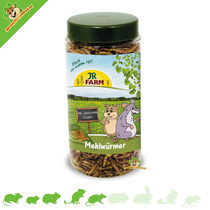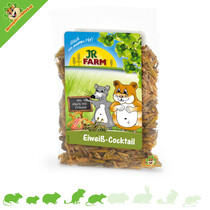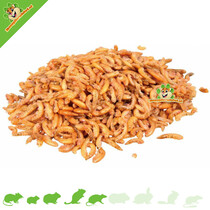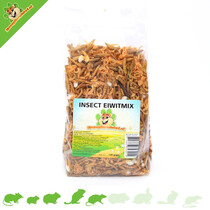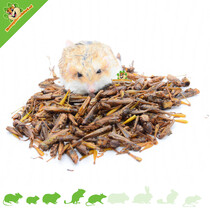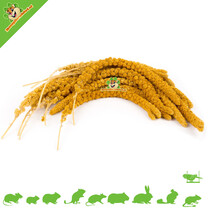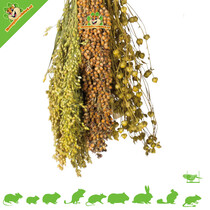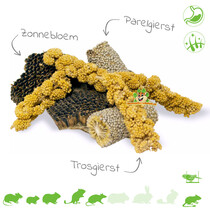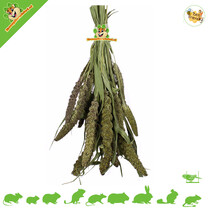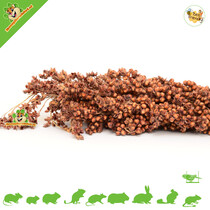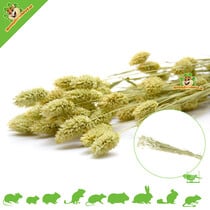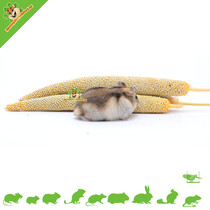Everything for our outdoor birds!
Feeding outdoor birds is now very natural! The Peanut Tower is made of natural hardwood in the shape of a house. It fits in any garden or balcony. Simply hang the peanut tower with the rope in a suitable place in the garden and fill it with the supplied p
Read moreWith extra vitamins! The JR FARM Peanut Butter has been specially developed for feeding wild birds and is naturally free from added salt. Particularly high-quality and peel-free recipe! Not suitable for human consumption. No broken glass in the garden: pe
Read moreThe JR Farm Peanut Butter Bar is especially for the Peanut Butter Tower! The "long" picking pleasure for all wild birds with special seeds for energy supply! The JR FARM Peanut Butter Bar is specially designed for feeding wild birds and is naturally free
Read moreVitakraft dried mealworms are a tasty treat for small rodents such as Mice, Gerbils, Hamsters and Rats. Because the mealworms are freeze-dried, the taste is retained and they have a long shelf life.
Read more- Voor 17 uur besteld morgen in huis!*
- Persoonlijk & deskundig advies
- Al 13 jaar een begrip!
Did you know that Mice, Hamsters, Gerbils and Rats really like dried silkworms? The silkworms are also a source of natural proteins for the animals and are therefore a healthy addition to your small rodent's diet. The silkworms are only suitable for all-e
Read moreTasty dried JR Farm Mealworms for small rodents. These delicious mealworms are an important source of protein for mice, hamsters, gerbils and rats.
Read moreThe JR Farm Silkworms are a nutritious and tasty source of high-quality animal protein. They are ideally suited for protein-oriented rodents such as hamsters, rats and mice. These dried silkworm pupae are not only crunchy, but also invaluable for young an
Read moreJR FARM Protein Cocktail is an ideal source of high-quality animal protein for all omnivorous rodents, such as gerbils, hamsters, rats or mice. Very small insects such as grasshoppers and mealworms, as well as crustaceans such as shrimp, are not only very
Read more- Voor 17 uur besteld morgen in huis!*
- Persoonlijk & deskundig advies
- Al 13 jaar een begrip!
Protein-rich and sun-dried gammarus crayfish for small rodents. The crayfish are only suitable for protein-eating rodents, such as Mice, Dwarf Hamsters, Hamsters, Gerbils and Rats. The Water lobsters or Vlokreefjes as they are sometimes called are 100% su
Read moreDried mealworms are a rich source of protein for small rodents. The mealworms are freeze-dried very quickly, which preserves the nutritional value. Small rodents such as mice, dwarf hamsters, hamsters, gerbils and rats also need protein in their diet. Dri
Read moreThe Little One Insect Mix is a delicious and above all very nutritious snack for all omnivorous rodents, such as: Mouse, Dwarf Hamster, Hamster, Gerbil and Rat. The mix is a valuable source of macro & micronutrients. Perfectly balanced and contains dr
Read moreDried mealworms are the perfect nutritious supplementary food for omnivorous rodents. It is not only their favorite snack, but also a valuable source of necessary animal protein. Adding mealworms will help diversify and enrich pets' diets.
Read more- Voor 17 uur besteld morgen in huis!*
- Persoonlijk & deskundig advies
- Al 13 jaar een begrip!
Delicious protein mix for omnivorous (protein eating) rodents such as: mouse, dwarf hamster, hamster, gerbil and rat. The mix is rich in dried mealworms, sun-dried amphipods, but also the larvae of the black soldier fly and a little puffed rice, in short,
Read moreDried Grasshoppers are a delicious and nutritious treat for small rodents. They provide a source of protein and can be a nice addition to the diet of animals such as mice, dwarf hamsters, hamsters, gerbils and rats. This tasty treat not only provides a ta
Read moreSurprise your rodents with a delicious and healthy treat in the form of Dried Red Spray Millet Stems. These crunchy and colorful stems not only provide a tasty distraction, but also a natural way to satisfy their gnawing needs.
Read moreYellow Spray Millet is a popular treat for both rodents and birds. This delicious yellow spray millet provides variation in the diet and offers a tasty change for your pets.
Read more- Voor 17 uur besteld morgen in huis!*
- Persoonlijk & deskundig advies
- Al 13 jaar een begrip!
The JR Farm Pick & Fly Dari, Millet and Linseed harvest is a natural delicacy with delicious, sun-ripened seeds. For long-lasting harvesting fun and activity for rodents and birds! The harvest is 100% natural, untreated and comes directly from the farmer.
Read moreTreat your rodents to the delicious gnawing pleasure of JR Farm Nibble Pieces Sunflower & Millet. These crunchy pieces are made from high-quality sunflower seeds and millet, providing a tasty and satisfying snack for your little friends.
Read moreSpoil your rodents and rabbits with the delicious JR Farm Green Senegal Millet. This natural food supplement is composed of tasty, sun-ripened seeds that provide fun to play and nibble on. The Senegal millet can serve as food enrichment and a decorative a
Read moreSorghum is a delicious and especially healthy snack for rabbits, guinea pigs, rats, hamsters, mice, chinchillas and degus. But larger parakeets and parrots also love the large grains of this type of millet. Sorghum is 70 percent starch, so it is a good so
Read more- Voor 17 uur besteld morgen in huis!*
- Persoonlijk & deskundig advies
- Al 13 jaar een begrip!
The JR FARM Dari Flask provides natural activity for your darling. The sun-ripened seeds must be harvested by the animal itself. That will keep them busy for hours. Hamsters like to pick the seeds and then hoard them in their pantry.
Read moreDiscover the taste and nutritional value of Canary Seed Harvest, a high-quality treat for your rodents. This carefully harvested canary seed is a tasty addition to your little friends' diet, allowing them to enjoy a diverse and nutritious menu.
Read moreThe JR Farm Canary Seed Harvest is sun-ripened and comes directly from the farmer. Treat your furry friends to a delicious and challenging treat with the JR Farm Canary Seed Harvest! These sun-ripened seeds straight from the farmer not only offer tasty ni
Read moreJR Farm Pearl Millet is a tasty treat that rodents and birds can enjoy as part of their diet. Pearl millet is a natural and nutritious grain that adds variety to your furry friends' diet.
Read moreOrder everything for the outdoor bird easily and quickly at DRD Knaagdierwinkel!
Outdoor birds are animals that belong to all of us and they can really use our help! Where we used to only support the birds in the winter, this is now necessary almost all year round. This is because there are fewer insects, we have built up much more and the natural habitat of many birds is shrinking.
In spring and summer, proteins are needed for outdoor birds
Birds are busy building nests and raising their offspring in the spring and summer. They need more proteins during this period to gain strength and maintain energy for the young. During the breeding season, birds need more protein. This can be in the form of: Dried mealworms , Dried amphipods , Dried grasshoppers , Dried insect mix , Dried silk caterpillars.
In winter, fat is needed for outdoor birds
For the winter, outdoor birds need fat to grow a layer of fat. This layer of fat protects the animals from the cold. It is good to start with fat seeds at the end of September/October so that the animals can optimally prepare for winter.
What should you not feed outdoor birds?
As tempting as it is, outdoor birds should not be fed human food scraps. Outdoor birds have specific nutritional needs that unfortunately do not match our food. Bread or dairy products are also not suitable for outdoor birds.
How do you make the Dutch garden animal-friendly?
Many Dutch gardens are tiled and have fences. Poison is often also sprayed. These are all circumstances in which garden animals do not feel at home and will stay far away. That's a shame because all the gardens in the Netherlands together form an area five times as large as the Oostvaardersplassen. Fortunately, more and more people are making their gardens pet-friendly! What is often a challenge here is the "how". How do you make your garden pet-friendly? We are happy to help with that!
Attract birds and other animals with food
We all know the fat balls that are hung outside for the birds in the winter, but did you know that birds can also be fed naturally through:
Flowers: Birds may not eat flowers, but they do eat the insects that come to the flowers and later the birds eat the seeds that fall from the flowers.
Shrubs and trees that produce fruit, berries or nuts.
A lawn where birds can find larvae and worms
Do not clean up fallen leaves . There is a lot of life under the leaves such as insects, worms, beetles, all of which are eaten by the birds
Making the garden safe for birds
Shelters are very important for birds. The animals must be able to hide from predators such as cats or sparrowhawks. A shelter can be very natural, for example a dense plant, shrub or ivy are perfect!
Help birds during nesting season
Birds make nests. Every bird has its own way and place for this, but we can help the birds very well with this, for example by offering them a nesting box. This way the birds can make their nest in a place that is very safe and they can return to the same place every year. Not all birds will take up residence in a nest box, it is the so-called "cave nesters" that do.
Every bird has its own wishes when it comes to the nest box and the entrance opening
Nowadays our houses are beautifully finished and cracks and holes are virtually impossible to find anymore, which also poses a challenge for the birds, because they can no longer nest in and near the house.
The greatest chance of success is a nest box that hangs in the "Northeast".
Then it doesn't blow or rain as much inside. Never hang the nest box in full sun, the birds do not like that because it will become too hot. You must also ensure a clear approach path, so no obstacles directly in front of the entrance to the nest box. In the autumn, when the nest box is no longer used by the birds, it is good to clean it with boiling hot water.
Attract many different birds through a lot of variety
You can attract most garden animals by adding a lot of variety to your garden or balcony. A nice added bonus is that you not only attract many garden animals, but also insects, bees and butterflies, which in turn creates a nice diversity. It is best to view the garden in layers. Ground covers, mid-height plants and dense shrubs or trees. If you really want to be crazy and drive the animals crazy, plant a berry hedge and you'll have a party in your garden! But different types of shrubs in a row that bloom at different times of the year also do very well and you have many animals in the garden at various times of the year.
A few good examples are: Guelder Rose, Privet, Firethorn, Blackthorn, Elder and Cardinal's Hat.
- Turn your garden or balcony into a bird paradise!
- Hang, place or screw (to the railing) a beautiful water bowl
- Place pots or, if there is more space, a vegetable garden container with flowers or herbs
- Place a small raspberry or other berry bush in a pot
- Grow a climbing plant along the boundary or balcony
- Hang a nest box in the shade for blue tits or great tits, for example, with a 3-in-1 house sparrow nest box under the eaves
- Hang up a food silo, we have very nice ones in our outdoor bird category
What are the most famous outdoor birds that we see in our garden?
The blackbird
The Latin name for the blackbird is Turdus merula. While a male has glossy, deep black plumage and an orange bill, the female's plumage is rather inconspicuous, being a subtle gray-brown. The adult blackbird is up to 25 cm in size and weighs about 110 grams. The blackbird's habitat is in dense climbing plants, as well as in shrubs and evergreens, as well as in dense trees. For food, blackbirds like insects, snails, beetles, earthworms, seeds, fruits and berries . Blackbirds can live up to 9 years in the wild (although this is not an average age as many of our wild birds die in their first year of life).
The Great Tit
The Latin name of the great tit is Parus major. The typical feature of the great tit is the yellow belly with a black vertical stripe. This stripe is narrower in the female than in the male. Her head and throat are also black, her cheeks are white. The yellow body color of females is generally paler than that of males. Characteristic of the blue tit: the blue tit wears a white "headband". The great tit is about 15 cm long and weighs about 20 grams. Great tits like to build their nests in caves as a place of residence. They also happily accept nest boxes . Favorites on the menu include insects, spiders, worms, fruits and seeds with a high oil content . In the wild the great tit can live up to 10 years (However, this is not an average age as many of our wild birds die in their first year of life).
The Robin
The Latin name for the robin is Erithacus rubecula. This plump bird is immediately recognizable by its orange-red color on the neck and chest. The sides of the neck and chest are blue-gray. Its beak is remarkably narrow. The size is a maximum of 14 cm and the weight is approximately a maximum of 19 grams. The robin likes to build its home close to the ground, in shrubs and undergrowth, but also in hedges, holes in walls or hollow tree stumps. It prefers to feed on insects, larvae and fruits, snails and spiders, worms and beetles . In the wild the robin can live up to 11 years (However, this is not an average age as many of our wild birds die in their first year of life)
The Wren
The Latin name of the wren is Troglodytes troglodytes. There are no external distinguishing features between men and women. Both are feathered in a rusty brown color. The wren likes to carry its tail upright. It also has a small, pointed beak that allows it to easily fish insects out of any crevice. With a size of only 10 cm and a weight of 10 grams, it is one of the smallest birds in Europe. Due to its short wings, it is not one of the best flyers and therefore jumps around a lot on the ground or in the bushes. But he is a gifted and very hardworking (and also loud) singer. As a place of residence, these birds like to build cozy and round nests with a soft interior of feathers and moss. Favorite food sources are insects, larvae, spiders, flies . In the wild the wren can live up to 5 years (not an average age as many of our wild birds die in their first year of life)
The Song Thrush
The Latin name of the song thrush is Turdus philomelos. The song thrush's back is brown and its belly is cream-spotted. The body length is up to 23 cm and their weight up to 90 grams. The special thing about this song thrush is its melodious song, which can be heard even at night. As a place of residence, he prefers coniferous forests, as well as dense undergrowth. It likes to line its nest with rotten pieces of wood, damp earth and loamy soil. The song thrush is often found in natural gardens that provide many insects as a food source. For food it prefers insects, larvae, snails, worms . In the wild, the song thrush can live up to 14 years (although this is not an average age as many of our wild birds die in their first year of life).
The crow
The Latin name of the carrion crow is Corvus corone. The entire plumage of the carrion crow is jet black and unmarked. This distinguishes it from its Eastern European twin, the hooded crow, which also has gray feathers in its plumage. They are up to 51 cm long and weigh up to 670 grams.
Carrion crows not only settle in parks, gardens and forests, but we can even find them in built-up areas in large cities. They build their nests in forests, both in twigs and in tall trees and various masts. Their food consists of insects and worms, snails, larvae, small vertebrates . This species also likes fruit and even kitchen scraps .
In the wild, the carrion crow can live up to 19 years (although this is not an average age as many of our wild birds die in their first year of life).
The blackcap
The Latin name of the blackcap is Sylvia atricapilla. The plumage of this bird consists of a brown-gray upper surface. The rest of the body is gray. The top of the head is black in the male and rusty brown in the female. And that's why it looks like this bird species is wearing a monk's hat. The blackcap is about 13 cm in size and weighs about 20 grams. The blackcap's favorite territory is semi-shaded parks with many shrubs and natural gardens. It usually builds its nest close to the ground in dense bushes and preferably in nettles.
In addition to berries and fruits, they look for insects, larvae and spiders for food. Since this bird likes to eat the sap of the mistletoe , it is one of the mistletoe dispersers.
In the wild, the Blackcap can live up to 5 years (However, this is not an average age as many of our wild birds die in their first year of life).
The Nuthatch
The Latin name of the nuthatch is Sitta europaea. Its short head sits on a short neck. It has a pointed and long beak and a short tail. The color of its belly is rust brown, its back has blue plumage. On the outside of his eyes he has a black stripe on both sides that resembles a mask. Characteristic of the nuthatch is that it can run along a tree trunk to fish hidden insects from the bark. It grows up to 15 cm long and weighs up to 25 grams. As a breeding ground, the nuthatch likes to take over high-altitude old nest holes from other birds or nests in nest boxes, which it usually closes with clay at the entrance. Hence the name "Klever". For food it prefers spiders, insects, tree seeds, beechnuts . In the wild, the Nuthatch can live up to 9 years (However, this is not an average age as many of our wild birds die in their first year of life).
The House Sparrow
The Latin name of the house sparrow is Passer domesticus. In coloration, males differ from the female's pale, dull brown markings and her light brown underparts with a black throat, light cheeks and an ash gray color at the center parting, as well as a brown dorsal plumage. The sparrow has a relatively large head, up to 16 cm in length and weighing up to about 30 grams. The house sparrow's home can be found under roof tiles, in gutters, in caves, alcoves, nest boxes or in crevices in walls and other buildings. The sparrow likes to fill its nest with feathers. The house sparrow loves to bathe. It is therefore advisable to place sufficiently large bird baths in the garden or on the balcony. For food it likes seeds and grains, fruits, berries and insects . In the wild, the house sparrow can live up to 15 years (this is not an average age, however, as many of our wild birds die in their first year of life).
The European Canary
The Latin name of the Canary is Serinus Serinus. The male's plumage is streaked with gray-yellow, the rump, chest and forehead are yellow and the tail is forked. The females are slightly larger, paler and browner. The size of a European Canary is about 11 cm, the weight is a delicate 13 grams. The Canary's typical identifying feature is its mini size (it is the smallest native finch) and its thick, short beak. This bird was nicknamed the "glass cutter" because of its ringing, high-pitched song. This bird prefers to build its nest in natural gardens on the outskirts of cities, more specifically in shrubs, dense conifers and climbing plants. The Canary likes to use grass, roots, moss and animal hair to make its nest comfortable. As a food source it looks for wild herb seeds, buds, young shoots and perennials and in summer it likes to eat insects .
In the wild, the European Canary can live up to 5 years (However, this is not an average age as many of our wild birds die in their first year of life).







